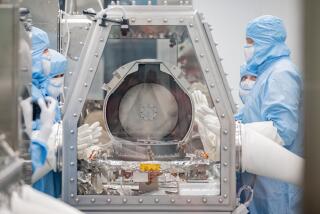Rare <i> T. rex </i> rests its bones at Smithsonian’s Museum of Natural History
WASHINGTON -- After a grueling 48-hour drive from Montana, the capital’s latest transplant -- a 38-foot long, 66 million-year-old Tyrannosaurus rex skeleton -- got to rest its bones Tuesday at the Smithsonian’s National Museum of Natural History.
The Smithsonian’s newest acquisition is one of the largest and most complete specimens in the world, and it will be the museum’s first real T. rex skeleton on display.
“What could be more fabulous than welcoming a Tyrannosaurus rex to Washington D.C.?,” said Museum Director Kirk Johnson at a welcoming ceremony. The skeleton is here on a 50-year loan agreement with the U.S. Army Corps of Engineers.
Johnson opened the first two boxes of bones, revealing teeth the size of bananas and a right femur bone about as tall as the gaggle of children gathered around the skeleton to watch the unveiling. The fossils will be displayed at the Museum of Natural History until National Fossil Day on Oct. 15, but will be back on display for a new exhibit scheduled to open in 2019.
The skeleton, originally called the Wankel T. rex, was first discovered on federal land in Montana in 1988. While hiking with her husband near the Fort Peck reservoir, local rancher Kathy Wankel found an odd shape jutting out of the ground.
After some perfunctory digging with a garden shovel and a jackknife, she unearthed the first complete T. rex arm that had ever been found.
Museum of the Rockies curator Jack Horner led the mission to excavate the rest. It remained the Montana museum’s crown jewel for decades.
In June, the Corps of Engineers, which oversees federal land where the skeleton was discovered, agreed to transfer the T. rex to the National Museum of Natural History, the second-most visited museum in the world. The move was originally scheduled for the fall but was delayed by the 2013 government shutdown.
In preparation for the 3,300-mile road trip, the bones were carefully packed into 16 inventoried wooden crates and placed inside an 18-wheel FedEx truck.
The travails of the T. rex are not over yet. The skeleton will be shipped again to Toronto, where it will be fitted with the mount and cradle that will support the bones in the full-height display.
The National Museum of Natural History will exhibit the reconstituted T. rex as the centerpiece of its new $48-million dinosaur hall. The refurbishment is being funded in large part by a donation from industrialist David H. Koch.
The skeleton is 85% intact, and its particularly well-preserved skull could help explain the giant predator’s eating habits. The skeleton has previously served to prove that the creature’s forearms -- about the same size as a human’s -- served a functional purpose rather than being vestigial limbs.
More to Read
Start your day right
Sign up for Essential California for news, features and recommendations from the L.A. Times and beyond in your inbox six days a week.
You may occasionally receive promotional content from the Los Angeles Times.






